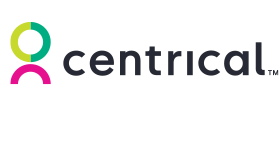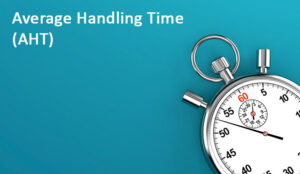Call centre average handle time, or AHT, is one of the most important metrics to drive success for your organization. It reflects many crucial areas of call centre performance, including customer satisfaction and operational efficiency – and it can be used to uncover underlying issues or to surface opportunities.
In this article, we’ll look at the mechanics underlying call centre average handle time, as we uncover seven key strategies to improve this business-critical benchmark.
What Is Call Centre Average Handle Time (AHT)?
Call centre average handle time is a metric that gives the average amount of time a call centre agent spends on a customer interaction.
This interaction can be a call, email, or chat, but what’s important to bear in mind is that AHT takes into account the entire process, including time spent after the direct interaction with the customer or “Total Talk Time + Total After-Call Work Time.”
For example, if an agent takes a call that lasts 5 minutes, and then after the call updates the CRM for 2 minutes and sends a follow-up email that takes 1 minute, the numerator of the AHT equation equals 8 minutes (5 + 2 +1).
This is one of the reasons for the centrality of AHT as a call centre metric: it provides a high-level overview of how efficient the contact centre is, and this granularity can be drilled down to the individual agent level.
What Is a Good Call Centre Average Handle Time?
It’s difficult to pinpoint a “good” call centre average handle time, due to different industries and call centre functions. However, there are some rough guides available.
Reports note that call centre average handle time ranges from 528 seconds for telecommunication companies, to 324 seconds for retail companies, and 282 seconds for business and IT services and financial services companies.
Other data shows industries such as healthcare & life sciences coming in as low as 149 seconds, and financial services coming in at an average of 208 seconds.
While there is no call centre average handle time standard, these numbers can provide a good approximation.
How To Calculate Call Centre Average Handle Time
Calculating call centre average handle time is based on a simple formula which takes the total amount of time directly interacting with customers (“Total Talk Time”) plus the total amount of time spent on post-call tasks such as following up or updating internal systems (“Total After-Call Work Time”), and dividing this by the total number of interactions for the period.
The call centre average handle time calculation is as follows: AHT = (Total Talk Time + Total After-Call Work Time) / Total Number of Interactions
Hold time is included in the call centre average handle time calculation, as is time spent escalating the call if necessary.
Importance of Call Centre Average Handle Time in Operations
Call centre average handle time is critical from an operational standpoint for a number of reasons, including:
Customer Experience
AHT directly impacts the customer experience. Customers generally prefer shorter wait times and faster issue resolution. If AHT is too long, customers may become frustrated, leading to lower customer satisfaction and possible churn. For AHT customer service that’s significantly improved is a key outcome.
Cost Efficiency
Call centre average handle time is closely tied to the cost of operations. Shorter AHT allows call centres to handle more interactions with the same workforce, improving cost efficiency.
Workforce Management
AHT is a critical factor in workforce management. By analyzing historical call centre average handle time data, call centres can forecast staffing requirements accurately.
Agent Productivity and Efficiency
Monitoring and managing AHT can help call centre managers identify areas for improvement in agent performance.
Service Level Agreements (SLAs)
Many call centres have SLAs in place that define specific performance targets, including call centre average handle time.
Identifying Bottlenecks
High AHT can be an indicator of potential bottlenecks or inefficiencies in call centre operations. By analyzing call centre average handle time along with other metrics, managers can pinpoint areas that require attention and improvement.
Resource Allocation
AHT helps managers determine how many agents are required during different times of the day or week. Properly allocating resources ensures optimal utilization of agent time.
Call Centre Metrics Benchmarking
Call centre average handle time is a fundamental metric used to benchmark call centre performance against industry standards and competitors.
Continuous Improvement
Monitoring AHT regularly allows call centres to identify trends and make continuous improvements to call centre processes, agent training, and technology, leading to better overall performance.
Operational Agility
Call centres with well-managed AHT can respond to fluctuations in call volumes more effectively. During periods of high volume, shorter AHT ensures that customers are served promptly, maintaining service levels.
7 Strategies to Optimize Call Centre Average Handle Time
We’ve put together 7 key, tested strategies to optimize the all-important call centre average handle time metric:
1. Agent Training and Coaching
Provide comprehensive training to agents, focusing on product knowledge, communication skills, and effective issue resolution techniques. Ideally, training should be AI-enhanced, real time, and personalized.
2. Leverage Technology and Tools
Invest in advanced call centre technology that aids agents in accessing customer information quickly and automates repetitive tasks.
What’s particularly important is to harness technology in building up agents with unified, guided experiences and performance-driven learning. Centrical uniquely provides this employee-centric approach through its Employee Performance Experience methodology.
3. Encourage Active Listening
Train agents to practice active listening, understand customer needs, and address concerns efficiently. Avoiding unnecessary repetitions and clarifying issues upfront can streamline the interaction process.
4. Promote First-Call Resolution (FCR)
Emphasize the importance of resolving customer issues on the first call. Encourage agents to gather all necessary information during the initial interaction to avoid follow-up calls and reduce overall handling time.
5. Prioritize Caller Segmentation
Categorize incoming calls based on complexity or issue type to route them to specialized teams or experienced agents.
6. Offer Self-Service Options
Implement self-service options such as Interactive Voice Response (IVR) systems or online knowledge bases.
7. Monitor and Analyze Call Data
Regularly track and analyze call centre average handle time data to identify trends, potential bottlenecks, and areas for improvement.
Measuring and Monitoring Call Centre Average Handle Time
Measuring call centre average handle time starts by having accurate tools in place to track the key components of the metric, i.e., talk times, after-call work times, and of course the total number of interactions.
Monitoring of this metric should be constant; any changes can indicate a serious underlying issue, such as staffing and training problems.
Benchmarking AHT against industry standards and other metrics like FCR and CSAT helps gauge performance, while continuous communication and feedback with agents foster a culture of improvement, ensuring optimal call centre average handle time without compromising service quality.
FAQs
What Is the Standard Call Centre Average Talk Time?
The standard call centre average talk time varies depending on the industry and the complexity of customer inquiries, but it typically ranges from 3 to 6 minutes per call.
What Is Average Handling Duration?
Average handling duration refers to the total time an agent spends on a customer interaction, including talk time and any after-call work, such as documentation or follow-up tasks.
How Do You Calculate Average Call Centre Hold Time?
To calculate average call centre hold time, add up the total hold time for all calls and divide it by the total number of calls during a specific period.
Effectively Optimizing Call Centre Average Handle Time
We looked at some basics, background, and mechanics of call centre average handle time, including what call centre average handle time is, the ideal length, and how to optimize call centre average handle time. Below are a few key takeaways:
Call centre average handle time is an important metric that can indicate the health of key operational areas, including customer experience, agent productivity and efficiency, resource allocation, and more.
The metric and its components should be constantly monitored for signs of larger issues, such as staffing and training.
This blog post has been re-published by kind permission of Centrical – View the Original Article
For more information about Centrical - visit the Centrical Website
Call Centre Helper is not responsible for the content of these guest blog posts. The opinions expressed in this article are those of the author, and do not necessarily reflect those of Call Centre Helper.
Author: Centrical
Published On: 29th Aug 2023 - Last modified: 9th Dec 2024
Read more about - Guest Blogs, Centrical






 Centrical provides a real-time performance management, microlearning, gamification, coaching, and voice of the employee platform for frontline teams. The solution inspires and personally guides employee success and growth by making every moment actionable.
Centrical provides a real-time performance management, microlearning, gamification, coaching, and voice of the employee platform for frontline teams. The solution inspires and personally guides employee success and growth by making every moment actionable. 






























